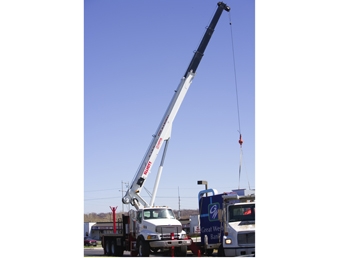The most common causes for crane accidents in urban environments are easily avoidable with good training, maintenance and plenty of planning. David Phillips, Manager, Global Business Development & Marketing at Elliott Equipment Company, says that two of the most common types of accidents are tip-overs and electrocution and presents ten tips to help you prevent this for occurring:
#1. When setting up the crane at a job site, make sure all outriggers and stabilizers are extended to level the truck and check to ensure that the ground is capable of supporting the imposed loads. The crane must be set up on a firm, level surface with adequate support for outrigger/stabilizer loads. Thin concrete, hot asphalt, and partially frozen ground may not support outrigger loads. Also ensure that there aren’t any voids under the surface like drainage lines or sewers.
Use cribbing and outrigger pads to assist in distributing loads. (Note: Plus outrigger pads will help avoid damage to the customer’s business front.)
#2. To prevent injuries and to ensure proper setup, each outrigger should be visible to the operator or to a signal person during extension or setting.
#3. If any portion of the lift creates a condition of blocked eyesight for the operator or when operating in or around hazardous areas like power lines, a signal person must be used. Because the operator is not in the best position to judge distances and may not be able to see all areas of the work area, a signal person may be necessary at other times.
The operator must understand standard crane signals and take signals from only one designated signal person. The operator, however, shall take a stop signal from anyone.
#4. Riggers must be able to accurately determine weights and distances and be able to select and properly use lifting tackle for the requirements of the lift. Riggers are also required to understand and abide by crewmember’s responsibilities.
#5. The operator must inspect the hoist equipment setup area before the personnel lift and report observations to the Personnel Lifting Supervisor. The operator must inspect the lifting area for potential hazards such as, but not limited to:
• Excessive load and/or radius;
• Overhead obstructions and electrical transmission lines;
• Hazardous locations;
• Inadequate surface and support to withstand all forces imposed;
• Wind, weather, and unstable conditions; and
• Any potentially hazardous conditions.
#6. To avoid electrocution, you should maintain a clearance of at least 10 feet (3.05M) between any part of the crane, load line, or load and any electrical line carrying up to 50,000 volts. One additional foot (.30M )clearance is required for every additional 30,000 volts or less.
Set ground markers in place to be used as a reference to assist in making sure the crane and load maintain minimum clearances required. Power lines and load lines deflect in wind and additional clearance must be provided.
If the electrical line voltage is unknown, contact the utility and obtain the voltage prior to operation. All overhead wires must be considered energized until the electrical utility representative verifies that they are not and the wires are visibly grounded.
Minimum Clearance Requirements
Nominal Voltage kV – Distance (Phase to Phase)
• Up to 50KV – 10 feet
• Over 50 to 200KV – 15 feet
• Over 200 to 350KV – 20 feet
• Over 350 to 500KV – 25 feet
• Over 500 to 750KV – 35 feet
• Over 750 to 1000KV – 45 feet
#7. Do not side load the boom. Side loading can result in sudden structural failure or tipping. Side loading occurs when rapidly starting and stopping swing operations, operating out of level, dragging or pulling loads sideways or operating in high winds.
#8. Do not lift loads if wind can create a hazard. Winds aloft can be much stronger than at the ground.
#9. All wire ropes should be thoroughly inspected at regular intervals. The longer it has been in service or the more severe the service, the more thoroughly and frequently it should be inspected.
Be sure to maintain records of each inspection. A person who has learned through training or practical experience what to look for and who knows how to judge the importance of any abnormal conditions discovered should carry out inspections.
#10. Most importantly, the operator and signalpersons and riggers must completely read and understand the operation and safety manual prior to using the crane. This is the best way to prevent injury and accidents. Be sure to keep the manual with the truck for quick reference if needed.
More installation coverage can be found in the July 2014 issue of Sign Builder Illustrated.











